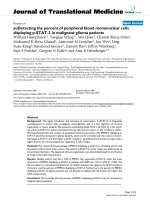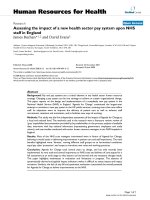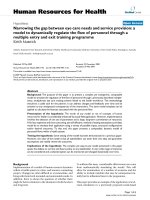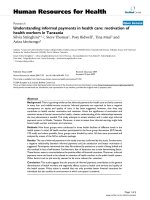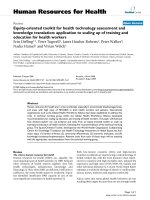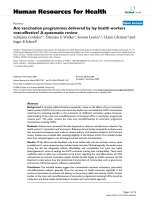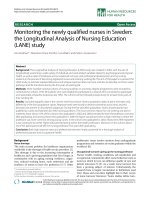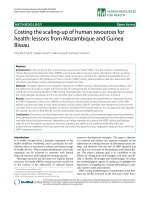báo cáo sinh học:" Narrowing the gap between eye care needs and service provision: a model to dynamically regulate the flow of personnel through a multiple entry and exit training programme" pdf
Bạn đang xem bản rút gọn của tài liệu. Xem và tải ngay bản đầy đủ của tài liệu tại đây (794.6 KB, 6 trang )
BioMed Central
Page 1 of 6
(page number not for citation purposes)
Human Resources for Health
Open Access
Hypothesis
Narrowing the gap between eye care needs and service provision: a
model to dynamically regulate the flow of personnel through a
multiple entry and exit training programme
Keith Masnick
Address: Institute for Eye Research and School of Public Health and Community Medicine, University of New South Wales, Kensington, Australia
Email: Keith Masnick -
Abstract
Background: The purpose of this paper is to present a complex yet transparent, computable
model to simulate the regulation of the flow of personnel through a previously described multiple-
entry, multiple-exit eye care training scheme linked to the health workforce. This methodology
should be a useful tool for the planner; it can address changes and feedbacks over time and be
sensitive to any unexpected consequences of the interactions. The same model template can be
applied to calculate the finances associated with the personnel flow.
Presentation of the hypothesis: The worth of any model or set of concepts of human
resources for health is considerably enhanced by actual field application. However, implementation
involves the selection of one set of parameters and a large, long-term commitment of resources.
A far less expensive and time-consuming, yet still effective, method of testing assumptions and ideas
would be to simulate their application using a variety of possible inputs, structural configurations
and/or desired outcomes. To that end, this paper presents a computable, dynamic model of
personnel flows within a health system.
Testing the hypothesis: Some testing of the model has been demonstrated in a previous paper.
However, the value of the model is that all stakeholders can enter their own data and parameter
assumptions and readily review the outcomes.
Implications of the hypothesis: The complex yet easy-to-use model presented in this paper
opens the debate on current and future policy to any stakeholder. A very wide range of scenarios
can be considered and a selected option can be monitored and changed dynamically over time.
Background
Implementation of a model of human resource dynamics
within a health system is a time- and resource-consuming
project. Changes are often difficult to accommodate, and
bring with them both intended and unintended results. In
addition, there is always the question of whether there
might be better solutions to the situation in both the short
and long term.
To address this issue, considerable effectiveness can come
from mathematically simulating the model. This will
allow for examination of a number of scenarios and the
ability to include variables that may be unimportant ini-
tially but be influential later in the programme.
This paper provides an example of the application of a rel-
evant simulation to a previously proposed needs-based
Published: 29 May 2009
Human Resources for Health 2009, 7:42 doi:10.1186/1478-4491-7-42
Received: 22 December 2008
Accepted: 29 May 2009
This article is available from: />© 2009 Masnick; licensee BioMed Central Ltd.
This is an Open Access article distributed under the terms of the Creative Commons Attribution License ( />),
which permits unrestricted use, distribution, and reproduction in any medium, provided the original work is properly cited.
Human Resources for Health 2009, 7:42 />Page 2 of 6
(page number not for citation purposes)
eye care training system [1] that is directly related to posi-
tions in a developing country's health scheme. This train-
ing programme would be more efficient, responsive and
cost-effective than the normal training plan by occupa-
tion.
At the outset it should be recognized that modelling is but
one tool to be used in the final decision of the structure of
an appropriate eye care system. It is beyond this paper's
scope to include discussions of complex interprofessional
and political interplay.
Options for graduates of Stage1 trainingFigure 3
Options for graduates of Stage1 training.
School
Leavers
Stage 2
Training
Existing W/F
Upgraded
Stage 1
Training
Refrac t-
ionist
Leave
Training
Leave Eye
Care W/F
Example of the use of a proposed modular training system for production of eye care personnelFigure 1
Example of the use of a proposed modular training system for production of eye care personnel.
J1
G2
G1
H2 F1
H1 E3
J1 E1 E2
D2 D2 E1
D1 D1 D2
C1 C1 C2 D1
B3 B3 B2 B3
B2 B2 B1 B2
B1 B1 A4 B1
A3 A3 A3 A3
A2 A2 A2 A2
A1 A1 A1 A1
Eye Car e Tr aining Modules
Eye car e nur se
Cataract
sur geon
Optometrist Ophthalmologist
Entrants into Stage 1 of trainingFigure 2
Entrants into Stage 1 of training.
School
Leavers
Existing W/F
Upgraded
Stage 1
Training
Human Resources for Health 2009, 7:42 />Page 3 of 6
(page number not for citation purposes)
The proposed training system is based on the notion that
all practitioners within eye care be trained with a selection
of topics from a common set of competences. The varia-
bles in the training system were the number of practition-
ers at specific occupational levels, their time to train and
the standard at which each competence would be applied
to each student. In theory this would allow any practi-
tioner to increase his or her range of competences by both
acquiring new ones and by lifting the standard of those
already attained. The advantage of this mobility is that it
injects a faster, less expensive and more flexible compo-
nent into workforce planning and avoids duplications.
Presentation of the hypothesis
In order to meet the varying needs of the eye care system,
a multiple entry and exit training programme (MEES) was
proposed whereby students leave training with a specific
set of competences at a number of predefined exits. They
can either remain at that level in the workforce or return
at a later stage to acquire a higher group of competences
to meet health system demands.
Common access to competences permits movement across
the normal professional training silos which increases the
flexibility of the training system to respond to changes in the
health service and improves understanding and respect
across the range of health workers. For example, as shown in
Fig. 1, a student who has completed the training elements for
an Eye Care Nurse could become an optometrist by adding
the training modules A4 and those from C2 to H2.
Within reason, these additional modules can be learnt
some time after the completion of the original set of mod-
ules. In the case of eye care, this permits the definition of
a new role of non-physician cataract surgeons based on
the competences of optometrists, nurses or similarly
trained clinical officers.
An essential step in improving the flow of students
through a MEES is estimating the initial number of stu-
dents and the proportion returning at each stage of higher
learning, as well as the number of graduates entering the
workforce at each stage.
Traditionally, these estimates are formed from the collec-
tive opinions of experts. However, the system is inherently
complex and constantly changing over time. It becomes
quite difficult, if not impossible, for a planner to integrate
all the interactions in a meaningful way.
To overcome this problem and to reduce uncertainty, a
computable dynamic model is proposed from which a
number of scenarios can be played out over time in order
to show the effects of a range of assumptions and esti-
mates. This type of modelling is a synthesis of a large
number of small units of activity and how each relates to
Training and workforce flow for the optometry sector of eye care personnelFigure 5
Training and workforce flow for the optometry sector of eye care personnel.
School
Leavers
Stage 2
Training
Stage 1
Training
Stage 3
Training
Stage 4
Training
Refract-
ionist
Visual
Technician
Opt om.
Technician
Optom -
etrist
Leave
Training
Leave Eye
Care W/F
Existing W/F
Upgraded
Entrants into Stage 2 trainingFigure 4
Entrants into Stage 2 training.
School
Leavers
Stage 2
Training
Existing W/F
Upgraded
Stage 1
Training
Refrac t-
ionist
Leave
Training
Leave Eye
Care W/F
Human Resources for Health 2009, 7:42 />Page 4 of 6
(page number not for citation purposes)
and interacts with its immediate neighbours and the sys-
tem as a whole. The inclusion of feedback and temporal
features makes the model dynamic and non-linear rather
than static and linear.
Testing the hypothesis
Building the simulation components of the MEES model
The proposed plan uses a stock (a group of identical indi-
viduals) and flow (the processes that change the level of a
stock) model. As a simple illustrative example, this simu-
lation uses only the four stages of optometry training.
Nurse, ophthalmology and community working modules
complete the model but are not part of the immediate
simulation. Figure 2 shows a stock of school leavers enter-
ing Stage 1 of training, together with existing workers
whose skills have been sufficiently upgraded.
At the end of the first year, graduates can either enter the
workforce as refractionists, move onto Stage 2 of training
or will have dropped out of the course. Some existing
refractionists will retire (Fig. 3).
Entry into Stage 2 will come from graduates who have
immediately completed Stage 1 and from the stock of
existing refractionists (Fig. 4).
This process shown in Fig. 4 is repeated for the four stages
of training (Fig. 5).
To complete the non-physician sector of eye care person-
nel deployment and training, eye care nurses have been
added. Both eye care nurses and optometrists can add fur-
ther training modules that will allow them to train as cat-
aract surgeons (Fig. 6). To keep the model from becoming
over-complex, it has been assumed that the number of
graduates at any level is below the optimum number
required for the workforce. Similarly, Eye Care Nurse is
shown as a stock (trained personnel – retirements).
To make the flows in Fig. 6 computable, iThink system
dynamics modelling software (ISEE Systems) has been
used. iThink has the advantage over spreadsheets in that
each individual flow can be readily visualized in the con-
text of the overall system structure and tested for both its
local and global effects. While spreadsheets show the
results of calculations, drilling down to the assumptions
and supporting stock/flow structure, equations and data is
more difficult than with iThink.
Entry into an eye care multiple entry and exit training schemeFigure 7
Entry into an eye care multiple entry and exit train-
ing scheme.
Training and workforce flow for the non-physician sector of eye care personnelFigure 6
Training and workforce flow for the non-physician sector of eye care personnel.
School
Leavers
Stage 2
Training
Existing W/F
Upgraded
Stage 1
Training
Stage 3
Training
Eye Care
Nurse
Stage 4
Training
Cat arac t
Surgeon
Refract-
ionist
Visual
Technician
Opt om .
Technician
Optom -
etrist
Upskill
Upskill
Leave
Training
Leave Eye
Care W/F
Human Resources for Health 2009, 7:42 />Page 5 of 6
(page number not for citation purposes)
Figure 7 illustrates the iThink rendering of Fig. 4. The
actual number of personnel involved in each of these
flows is calculated by using conditions within the convert-
ers (circles) attached to flow taps by connectors (curved
arrows). For example, the converters labelled Year 12
school leavers who will enrol and Existing industry workers
determine how many school leavers flow into stage 1 of
the optometry programme. Converters can either be con-
stant (the same number in each period) or can be deter-
mined by a formula that reflects changing conditions.
Figure 8 shows the complete iThink model of the non-
physician sector of eye care. Using a computable model
Scenario 1 of personnel flow through a MEES modelFigure 10
Scenario 1 of personnel flow through a MEES model.
The computable model of an eye care MEES showing the stocks and flows of personnel through training and into and out of the workforceFigure 8
The computable model of an eye care MEES showing the stocks and flows of personnel through training and
into and out of the workforce.
Personnel enter and leaving training and the workforce 2009 – 2028Figure 9
Personnel enter and leaving training and the work-
force 2009 – 2028.
Publish with Bio Med Central and every
scientist can read your work free of charge
"BioMed Central will be the most significant development for
disseminating the results of biomedical research in our lifetime."
Sir Paul Nurse, Cancer Research UK
Your research papers will be:
available free of charge to the entire biomedical community
peer reviewed and published immediately upon acceptance
cited in PubMed and archived on PubMed Central
yours — you keep the copyright
Submit your manuscript here:
/>BioMedcentral
Human Resources for Health 2009, 7:42 />Page 6 of 6
(page number not for citation purposes)
makes it possible to simulate a range of scenarios to pre-
dict the dynamic effects of the assumptions introduced
into the model.
Two scenarios
Figure 9 shows the source of entrants into the programme
between 2009 and 2028. Figures 10 and 11 show two dif-
ferent scenarios in which it has been assumed that all
school leavers move through the stages without failure or
leaving; that all existing industry workers enter the work-
force at the end of each stage of training and entrants after
2018 must progress to stage 2. In scenario 1 after two peri-
ods (years) in the workforce at each exit point, 10% of
refractionists re-enter stage 2 training, 25% of visual techni-
cians re-enter stage 3 training but no optometry technicians
enter final optometrist training. In scenario 2, in order to
encourage a higher standard of service, after 2018, 30% of
refractionists re-enter stage 2 training, 40% of visual tech-
nicians re-enter stage 3 training and 25% of optometry tech-
nicians train to become optometrists. The result of the new
policy change is that there are fewer refractionists but more
optometry technicians and optometrists.
Other complementary models
The example shown has a number of complementary
models. The existing workforce shown in Fig. 2 can be
readily expanded to included community health and
basic eye care workers. Similarly, graduates at any the exit
points shown in Fig. 6 can enhance their skills in many
subspecialties.
At a later date, the financial data associated with the per-
sonnel flows will be addressed by adding the costs associ-
ated with those flows or states and estimating the benefits
or effects of the personnel numbers. This is essentially an
activity-based costing method.
Implications of the hypothesis
Simulation of a model is an effective and efficient tool
that should be used with all human resource models. To
show its application, a computable model has been pre-
sented to describe the flow of personnel though a multi-
ple-entry, multiple-exit training scheme and thence into
the health workforce. The model presented allows a plan-
ner to integrate accessible yet complex interactions by
simulating and compensating for the effects over time of
a range of differing scenarios. By understanding complex-
ity and the environment within which the model will
operate, intended and unintended consequences can be
observed and adjusted.
Competing interests
The author declares that they have no competing interests.
Acknowledgements
The author appreciates the assistance given to him by John Dewdney, Geoff
McDonnell and Mark Heffernan.
References
1. Masnick K: Narrowing the gap between eye care needs and
service provision: the service-training nexus. Hum Res Health
2009, 7:35.
Scenario 2 showing an accelerated personnel flow through a MEES modelFigure 11
Scenario 2 showing an accelerated personnel flow
through a MEES model.
